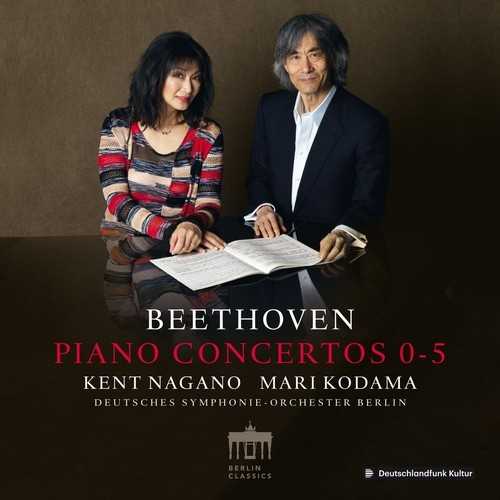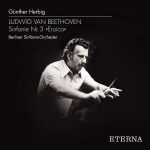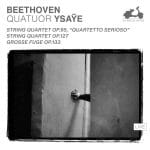
Composer: Ludwig van Beethoven
Performer: Mari Kodama
Orchestra: Deutsches Symphonie-Orchester Berlin
Conductor: Kent Nagano
Audio CD
Number of Discs: 4
Format: FLAC (tracks)
Label: Berlin Classics
Size: 3.91 GB
Recovery: +3%
Scan: cover
Piano Concerto No. 0, WoO 4
01. I. Allegro moderato
02. II. Larghetto
03. III. Rondo. Allegretto
04. Rondo for Piano and Orchestra in B-Flat Major, WoO 6. Allegro
Eroica Variations, Op. 35
05. Introduction. Allegro vivace
06. Theme
07. Variation 1
08. Variation 2
09. Variation 3
10. Variation 4
11. Variation 5
12. Variation 6
13. Variation 7. Canone all’ottava
14. Variation 8
15. Variation 9
16. Variation 10
17. Variation 11
18. Variation 12
19. Variation 13
20. Variation 14 (minore)
21. Variation 15. Largo (maggiore) – Attacca coda
22. Finale (alla Fuga). Allegro con brio
Piano Concerto No. 1 in C Major, Op. 15
23. I. Allegro con brio
24. II. Largo
25. III. Rondo. Allegro scherzando
Piano Concerto No. 2 in B-Flat Major, Op. 19
26. I. Allegro con brio
27. II. Adagio
28. III. Rondo. Molto allegro
Piano Concerto No. 3 in C Minor, Op. 37
29. I. Allegro con brio
30. II. Largo
31. III. Rondo. Allegro
Triple Concerto in C Major, Op. 56
32. I. Allegro
33. II. Largo
34. III. Rondo alla polacca
Piano Concerto No. 4 in G Major, Op. 58
35. I. Allegro moderato
36. II. Andante con moto
37. III. Rondo vivace
Piano Concerto No. 5 in E-Flat Major, Op. 73
38. I. Allegro
39. II. Adagio un poco mosso
40. III. Rondo. Allegro
Together with the Berlin-based Deutsches Symphonie-Orchester (DSO) Mari Kodama and her husband Kent Nagano have now completed the recording of all of Beethoven’s piano concertos by jumping, as it were, back in time twice: the last element of this recording series that has spanned more than 13 years was Beethoven’s concerto “number nought” (WoO 4) – personally edited by Mari Kodama from the autograph score.
The original manuscript of this piano concerto is kept at the State Library in Berlin. This is not a completed score, because there is no orchestration. That said, Beethoven annotated the short score, especially in the first two movements, with indications as to which instrument was to play which part. The orchestra score which is available today was written in the early twentieth century based on those annotations. The only problem is: “Today, armed with the knowledge we now have acquired about the young Beethoven, we would perform this concerto quite differently in places,” explain Mari Kodama and Kent Nagano in unison. They therefore present a very personal adaptation that emerged during rehearsal with the orchestra and at the recording sessions, and which reflects Kodama’s and Nagano’s individual image of Beethoven. They aim to make audible the exuberant freshness and urgent sense of awakening in the young, almost childlike Beethoven’s writing shortly before his artistic powers were to burst forth, the joie de vivre and vital energy in a style that owes something to the playfulness of both Haydn and Mozart. That is Mari Kodama’s intention, and she plays it in precisely such a versatile manner.
Combined with the classical canon of the piano concertos nos. 1–5, the resulting comprehensive edition is complemented by the Triple Concerto for piano, violin and cello op. 56, the Rondo WoO 6 and the Eroica Variations op. 35, offering insight into the artist’s longstanding involvement with her musical companion Ludwig van Beethoven. And the recordings of his works seem to lead the listener through the composer’s life. “If you play all of them, it is like accompanying Beethoven on a journey through his life,” explains Mari Kodama, and Kent Nagano adds: “You acknowledge the musical genius and at the same time you recognise the development of European music, because Beethoven was undoubtedly its pioneer.” He led the way in changing the structure, form and harmony of music, just as there was an equally radical shift in the world around him; after the French Revolution society and business and the incipient industrial revolution began to alter the way people lived.
“He is and remains an optimist, someone who can do no other than believe in what he wishes to communicate to us through his music,” explains Kodama. She says this helps her. The fact that she herself is an optimist can partly be attributed to Beethoven. Kodama, Nagano and the DSO – one might imagine them almost as a trio where all the musicians have blind faith in each other and are therefore able to produce a degree of musical intensity that brings the young Beethoven back to life.



